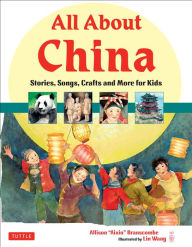By Amanda Andrei
The All About Asia series is the children’s version of a folklore handbook, a user-friendly encyclopedia, a DIY manual for experiencing an Asian country’s culture from a youth’s point of view. We explored All About China by Allison “Aixin” Branscombe and illustrated by Lin Wang, All About Japan by Willamarie Moore and illustrated by Kazumi Wilds, and All About the Philippines by Gidget Roceles Jimenez and illustrated by Corazon Dandan-Albano.
Each book is written and illustrated by a different pair of creators and has its own distinct look and feel from the others, yet still cover many of the same topics, such as history, geography, art, cuisine, mythology, literature, architecture, and sports. Many of these topics also have culture in practice—the reader (or teacher or parent) can create different crafts, experiment with multiple recipes, play songs (with musical notations, not just lyrics!), rehearse dance choreography, or integrate holiday traditions.
Best of all is the “day-in-the-life” of at least two different children—the reader’s guides—in their respective homes, whether urban or rural, north or south, busy or relaxed. These situate the children readers in real-world examples of culture and prepare them for learning about other people and places, whether in a foreign language course or traveling abroad. Not to mention—these stories are plain fun to read.
All About China has a tremendous amount of research in it, spanning four thousand years of Chinese history and even touching briefly on modern politics. Child guides Meling and Liming float by every few pages or so with comic-esque bubbles with trivia and questions for the reader. Illustrations are rendered realistically and faithfully, along with many full-color photographs. The amount of information is commendable, if a bit overwhelming. Some areas of the book feel sparse, such as the two pages on language compared to twelve pages on holidays and festivals (the latter including recipes and myths). The language section, although including common words and phrases, numbers, and vocabulary for the human body and clothes, does not discuss tones or the differences in writing systems (pinyin and characters), and makes passing references to other languages and dialects. On the other hand, it’s possible that including any additional information might have gone well beyond any page limits—and nonetheless, the book at the very least serves to pique the reader’s curiosity. At its best, it is a superb and fun reference guide about Chinese culture, history, and life for young readers.
All About Japan focuses more on the everyday life of its two guides, Yuto and Momoka, and the book is more integrated with their activities and families. Illustrations are reminiscent of a softened anime style, and large colorful pictures fill the pages—particularly joyful is a two-page spread of a multigenerational family picnicking beneath the sakura (cherry blossoms), the airy pink petals covering the top and drifting to the happy family below. Yuto’s story takes place in the country and includes a delightful description of how the family takes baths; Momka’s story occurs in the city and describes her experience going to juku, cram school. In the cuisine sections, the recipes call for authentic ingredients (such as katsuo-bushi, dried bonito flakes; beni-shoga, red ginger; and mochiko, rice flour) and may seem intimidating to a new kitchen novice, but offer a fun challenge with the reward of a sweet or savory snack. Although readers looking for more Japanese history may need to supplement this book with others, this charming book revels in the art and delights of past and present Japanese culture.
All About the Philippines addresses the diversity and unity of the country with guides Mary, Jaime, and Ari (who all happen to be cousins), representing each major region’s culture, history, religion, and ethnic makeup. The images are warmly cartoony, popping with colors and happy faces. The discussion of the Philippines’ environment is particularly relevant and intriguing, noting the archipelago’s susceptibility as one of the most disaster-prone countries on earth, the gradual disappearance of the rainforest and coral reefs, and the breathtaking natural sites such as the Palawan underground river and Bohol Chocolate Hills. While the section on disasters focused more on impacts to geology instead of culture, the section on disappearing environmental resources was educational and sobering—perhaps planting seeds for future conservationism and ecological activism? This book paints a rich view of the variations and unifications of Filipino life.
All in all, these books are excellent introductions to Asia for late elementary or early middle school readers. They also contain additional resources (books, websites) for further exploration. While these books would be good for anyone who wants to learn more about each Asian country’s culture, history, and geography, these are especially helpful and intriguing for Asian American youth learning about their heritage and personal histories. Here’s hoping that the All About Asia series will expand to cover all the other countries and cultures of such a diverse continent.
Other books in the All About Asia series include All About Korea, All About Indonesia, and All About Thailand. These books are distributed via Tuttle Publishing.
 Asian Fortune Your source for all things Asian American
Asian Fortune Your source for all things Asian American




